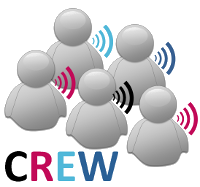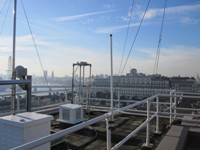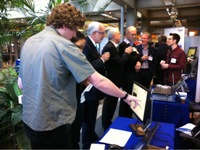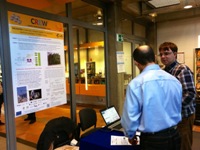FP7 CREW
Cognitive Radio Experimentation World
|
| |
| |
March 2015
|
Dear subscriber,
|
|
The FP7-CREW (Cognitive Research Experimentation World) project has now been running for more than four years! In this issue of the CREW newsletter, information is given about our presence at Net Futures this week as well as about the Open Access we are offering to our facilities. Furthermore, you will find CREW's past presence at Mobile World Congress and ETSI RSS, the Ofcom trial and success stories of the Open Call 3 experiments.
|
CREW @ Mobile World Congress
|
|
CREW together with the EVARILOS project was selected as one of the demonstrators at the EU 5G booth at the Mobile World Congress 2015. In the CREW/EVARILOS demo, we have shown a benchmarking framework that measures the performance of a specific indoor localization solution in different physical wireless environments (office versus industrial environment) and under different interference conditions (ranging from no interference to heavy interference). The booth has attracted many visitors, among others , Günther H. Oettinger, European Commissioner for Digital Economy (see picture) and Society, Andrus Ansip, Vice-president EC, Digital Single Market, and Mario Camoplargo, Director for 'Net Futures’ in DG CONNECT.
More information about the demo at MWC is on our website.
Go back to the top of the page.
|
CREW @ Net Futures
|
|
The joint CREW- WiSHFUL stand at Net futures Brussels on 25-26 March 2015 will explain
- what are the challenges in developing wireless solutions
- what is dynamic spectrum access and cognitive radio and
- how can reconfigurability, reprogrammability and testbed portability help creating better solutions.
Therefore the participation will include a poster and a demo.
The poster will explain the challenges specific to wireless networks that many developers and companies are not aware of. The challenges have been distilled based on intense contact with industrial and academic research partners in CREW and other projects. Using the challenges listed in the poster, it will be explained how reconfigurability, reprogrammability and testbed mobility help to improve the performance of wireless communication.
The Demo will be catchy and serve a double purpose: to attract visitors and to get a basic intuition of dynamic spectrum access. Entitled Spectrum Wars, it consists of an interactive game for up to 4 players. Two teams compete using software radios to transmit as much data as possible over a single wireless link using a common spectrum band. Players must contend with interference from the opposing team. This demo received the best demo award at DySpan 2014 and competed in the US DARPA challenge.
Go back to the top of the page.
|
Ofcom trial
|
|
In January 2015, CREW project has deployed two SNE-ESHTER spectrum sensors in London to monitor the ongoing Ofcom TV white spaces trials and record long-term statistical data on spectrum occupancy. The UK communications regulator Ofcom is currently running a pilot program for secondary devices using terrestrial TV broadcasting frequencies in preparation for authorization of commercial use of white space technology later this year. Sensors were deployed on roof-tops at King's College London (with a beautiful view over the London Eye and the Houses of Parliament, see picture) and Queen Mary University of London in cooperation with the FP7 ACROPOLIS project. SNE-ESHTER is a radio receiver for VHF and UHF bands designed within the CREW project and based on Jožef Stefan Institute's VESNA sensor platform. Measurements will be used to support experimentation with advanced spectrum sensing algorithms and cognitive radio devices.
The measurements from the sensor at KCL is already live.
Go back to the top of the page.
|
CREW @ ETSI RRS workshop
|
|
On the 3rd and 4th of December the ETSI RRS TC organized a workshop on the status and novel standards concerning reconfigurable radio systems. CREW was represented at this event with 3 demos:
- SNE-ESHTER: A low-cost, compact receiver for advanced spectrum sensing in TV White Spaces (JSI)
- Combination of TV White Spaces database access with infrastructure sensing (IT and JSI)
- Cross-technology TDMA in the 2.4 GHz ISM band using programmable MAC solutions on COTS hardware (CNIT and iMinds)
There was significant interest in the work of CREW and the CREW facilities. More information on this workshop can be found here.
This workshop was accompanied by regular WG meetings, where CREW attended the WG2 meetings that deal with the design of a new "Radio
Equipment Architecture".
Since then CREW members have attended the follow-up WG2 meetings and we plan to more actively contribute to this work in the future.
Go back to the top of the page.
|
OC3 Success stories
|
|
The CREW facilities are open, on a best effort basis, to all users that wishes to test and evaluate their cognitive radio networking solutions. Through the Continuous Open Call mechanism, the facility owners also provide support to these experimenters if needed. In the first unfunded Open Call of the CREW project, 7 proposals were accepted and supported by the facility providers. We briefly present the most successful SME and the most successful academic project.
TASS, Belgium
picoMESH was an experiment proposed by TASS, on the iMinds testbed, aiming to prove that the Optimized Link State Routing Protocol (OLSR) (IETF RFC3626) implementation provided by PicoTCP fits a scenario where a mesh topology based on IEEE 802.15.4 is challenged by multiple issues (i.e. nodes with a limited visibility or partially hidden, nodes joining and leaving the topology with no notice, embedded devices with limited capabilities). While executing the project, the company was able to detect and fix software bugs in their code as well as to reach their aim by running OLSR on a 55 node facility. They gained significant know-how with porting their code on embedded wireless devices and they also learned how to debug large networks.
Technical University of Cluj-Napoca (TUCN), Romania
GAME-COG-NET was an experiment proposed by TUCN, on the JSI testbed, aiming to show the feasibility of power control games to enable the co-existence of several IoT devices over a relatively small area. The experiment was successfully performed resulting in a submitted journal publication. During this work, it was shown that most of the theoretic frameworks need serious reformulation and adaptation to work in real set-ups. Additionally, most games only rely on signal to noise ratio while considering cross-layer metrics such as packet received ratio seems to be a more practical approach.
Go back to the top of the page.
|
Continuous open access
|
|
CREW is still in a continuous open access phase, offering 2 modes for the use of the CREW facilities:
- Best effort access & basic support: CREW offers best effort access to the facilities free of charge for non-commercial use, including basic support (i.e. information from portal, guidelines, tutorials, handbooks, and limted technical support). The CREW portal will guide you to find the most suitable test facility for your experiment along with further information on how to get started.
- Guaranteed access & advanced support: If more guarantees are required on the availability of infrastructure and more advanced technical support is needed, it is possible to submit a proposal application for an open access experiment with guaranteed availability & support. If the request is granted, CREW commits to provide the necessary facility resources and manpower to the experimenter, free of charge. Both the template for 'request for experimentation' and announcement document are available.
Go back to the top of the page.
|
|
|
|
|



